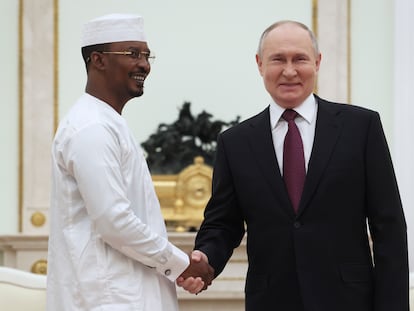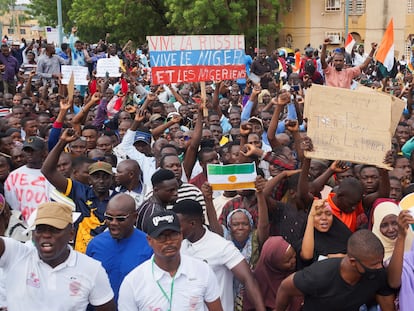The trip that two Burkina Faso athletes and their bodyguards took to represent their jihadist-controlled homeland
Young people from Sahel, an epicenter of global terrorism, traveled 185 miles in a military convoy, dodging landmines and attacks, to participate in a national championship
“When you see that the traditional fighting listings say the name of all the regions besides your own, the Sahel, you can’t sleep,” says 22-year-old Issouf Diallo. The young man is from Dori, the capital of the administrative region of Sahel, the northernmost part of Burkina Faso. His city has lived under a jihadist blockade from more than two years, which means that the sole road that connects it to the rest of the country is not always open due to dangers of terrorist attacks and landmines. But Diallo is clear: “If they tell you that you have to go represent your region at the national level, you have to go, even if it’s in a military convoy.” And that’s exactly what he did.
Diallo competed from April 27 to May 4 in archery and traditional fighting during the national championship that was held in the city of Bobo-Dioulasso, in the southwestern part of the country, as part of National Culture Week. Every two years, the event brings together artists, artisans and dance, traditional fighting and archery groups from the 13 regions of Burkina Faso. The young man’s travel partner, 25-year-old Kadiata Tamboura, won third place in women’s traditional fighting. “I am very proud to represent my region and be able to express myself, show our resilience,” she says.
The Sahel has the highest number of internally displaced people out of any region in Burkina Faso, at 500,000 out of a total of two million residents, according to the latest U.N. report from the end of January. This is due to jihadist violence in the region, which has been exacerbated by extreme poverty and climate change. Nearly half of the country’s territory is outside state control.
Diallo and Tamboura hadn’t left Dori for more than two years, a result of the control that terrorist groups wield over the region’s roadways. But this time, thanks to the deployment of a military convoy that accompanied them while traveling the 185 miles that separate Dori from the country’s capital, Ouagadougou, they participated in the National Culture Week, which attracted some 1,535 artists and athletes from throughout the country. “Every couple of kilometers we had to stop; you can’t imagine what we have had to witness. That’s why we sang to keep morale high during the journey,” says Tamboura.
In truth, the convoy wasn’t formed to accompany the athletes from Sahel alone. With them were hundreds of trucks weighed down with supplies and gasoline, upon which the million-plus people who live in the region depend for their survival, according to the Burkinabe National Institute of Statistics. The Support Group for Islam and Muslims (JNIM are its initials in Arabic) is one of the most active jihadist groups in the Sahel, and they erect checkpoints on its roads to “check personal identity, steal motorcycles, food and gasoline and well as make you pay a toll in exchange for security,” according to a report issued by ACLED, a conflict-monitoring organization.
Sport as an escape route
Kadiata Tamboura practices traditional fighting, a sport that is normally reserved for men. “Before I began, people tried to discourage me, but I stopped listening to what they said and continued on,” says the young woman, who returned home with a prize of $163. Diallo wasn’t as lucky, but he hasn’t had the same kinds of opportunities either. “I waited four months for the wood to get to Dori to build my bow and arrows, but I wasn’t able to practice until I got to Bobo-Dioulasso.” At night, when they weren’t competing, his peers turned on their phones’ flashlights and put together a makeshift archery training camp at the Sangoulé Lamizana Stadium in Bobo-Dioulasso, which is the country’s second-largest city.
Leaving Dori meant the two young people could breathe again. “We’ve relaxed a little,” says Tamboura, who made the journey with 15 other young people. “One day we were sleeping and a door slammed shut, everyone woke up terrified. We weren’t living in peace,” says the young woman, who studied livestock production, her family business.
The majority of the population of the Sahel is of the Peuhl, also known as Fulani, ethnicity. They are characterized by being nomadic, raising livestock and are today one of the country’s most stigmatized groups, accused of links to terrorism due to the pronounced presence of its members in jihadist groups. Dori was once one of the most active sheep, lamb and cow market in the Sahel and traded with Mali and Niger. “Before, I’d take the cattle outside the city. Now, by six in the afternoon I’m locked inside my house,” says Tamboura.
Diallo studies sociology at the university in Dori. Though the Sahelian sun is not beating down in Bobo-Dioulasso, he is wearing his community’s traditional hat, called tinguarê in the Fulani language. “He is more afraid than I am because he is a man,” Tamboura says, pointing to her companion.
Living in the epicenter of global terror
Mali, Burkina Faso and Niger, which together form Africa’s central sub-Saharan region, have become an epicenter of terrorism, site of one in every three worldwide deaths attributed to jihadism, according to a report published by the Institute for Economics and Peace. Though Tamboura hasn’t read that paper, she’s well-aware of such facts: “Right now, young people have realized that only battle can free us, that it’s necessary to rise up, unite and defend ourselves. There are many young people who have joined the Homeland Defense Volunteers,” she says, referring to the 50,000-plus member civilian militias that are armed by the government, and that act alongside the army.
“Even women play a very important role,” says Diallo, at which Tamboura does not chime in. When asked about the nature of that role, the young man limits himself to speaking of the current state of danger. There is some information that cannot be shared.
At the moment, Tamboura and Diallo both hope to return to Dori as soon as possible, although they don’t know when they’ll be able to make that trip. They must wait to return with the convoy, and those logistics are subject to military decisions. Diallo doesn’t want to talk anymore about these risks, only of the future. “I have the guiding stick [insignia of the Peuhl ethnic group that has been used historically for guiding cattle] and for now, I would like to work in civil service,” he says. He doesn’t have to go far from home because “extraordinary things can also happen in the capital of the Sahel,” a region where eight out of 10 young people are out of school and unemployed.
Aarouna, Diallo and Tamboura’s coach and booster of traditional fighting in the Sahel, says, “There are young people who study, others who work and others who don’t do anything, so sport is a way of organizing them so that they don’t get into other activities.” “When you tell people you’re from the Sahel, people are surprised,” Aarouna continues. “With traditional fighting, we don’t seek to harm the adversary, but rather make them wind up with their back on the floor.”
It’s a sport that feeds on passion and tradition. In combat, griots [traditional narrators] sing and make music to remind fighters that “their ancestors make them better” and to motivate them. “We train on the weekends, but there are many students who also have to work, so it’s complicated,” says Aarouna, who concludes: “We can’t leave the city, but we strive to continue living our life.”
Sign up for our weekly newsletter to get more English-language news coverage from EL PAÍS USA Edition
Tu suscripción se está usando en otro dispositivo
¿Quieres añadir otro usuario a tu suscripción?
Si continúas leyendo en este dispositivo, no se podrá leer en el otro.
FlechaTu suscripción se está usando en otro dispositivo y solo puedes acceder a EL PAÍS desde un dispositivo a la vez.
Si quieres compartir tu cuenta, cambia tu suscripción a la modalidad Premium, así podrás añadir otro usuario. Cada uno accederá con su propia cuenta de email, lo que os permitirá personalizar vuestra experiencia en EL PAÍS.
¿Tienes una suscripción de empresa? Accede aquí para contratar más cuentas.
En el caso de no saber quién está usando tu cuenta, te recomendamos cambiar tu contraseña aquí.
Si decides continuar compartiendo tu cuenta, este mensaje se mostrará en tu dispositivo y en el de la otra persona que está usando tu cuenta de forma indefinida, afectando a tu experiencia de lectura. Puedes consultar aquí los términos y condiciones de la suscripción digital.
More information
Archived In
Últimas noticias
Welcome to the post-religion era: The idea of Christianity as the absolute truth has become obsolete
‘I thought you would like it’: The risky sexual practice popularized by TV shows and TikTok
The digitalization of tourism: ‘They promise experiences and gave us the worst possible one’
Mexican peso defies uncertainty with forecasts of a new period of stability in 2026
Most viewed
- Sinaloa Cartel war is taking its toll on Los Chapitos
- Oona Chaplin: ‘I told James Cameron that I was living in a treehouse and starting a permaculture project with a friend’
- Reinhard Genzel, Nobel laureate in physics: ‘One-minute videos will never give you the truth’
- Why the price of coffee has skyrocketed: from Brazilian plantations to specialty coffee houses
- Silver prices are going crazy: This is what’s fueling the rally










































